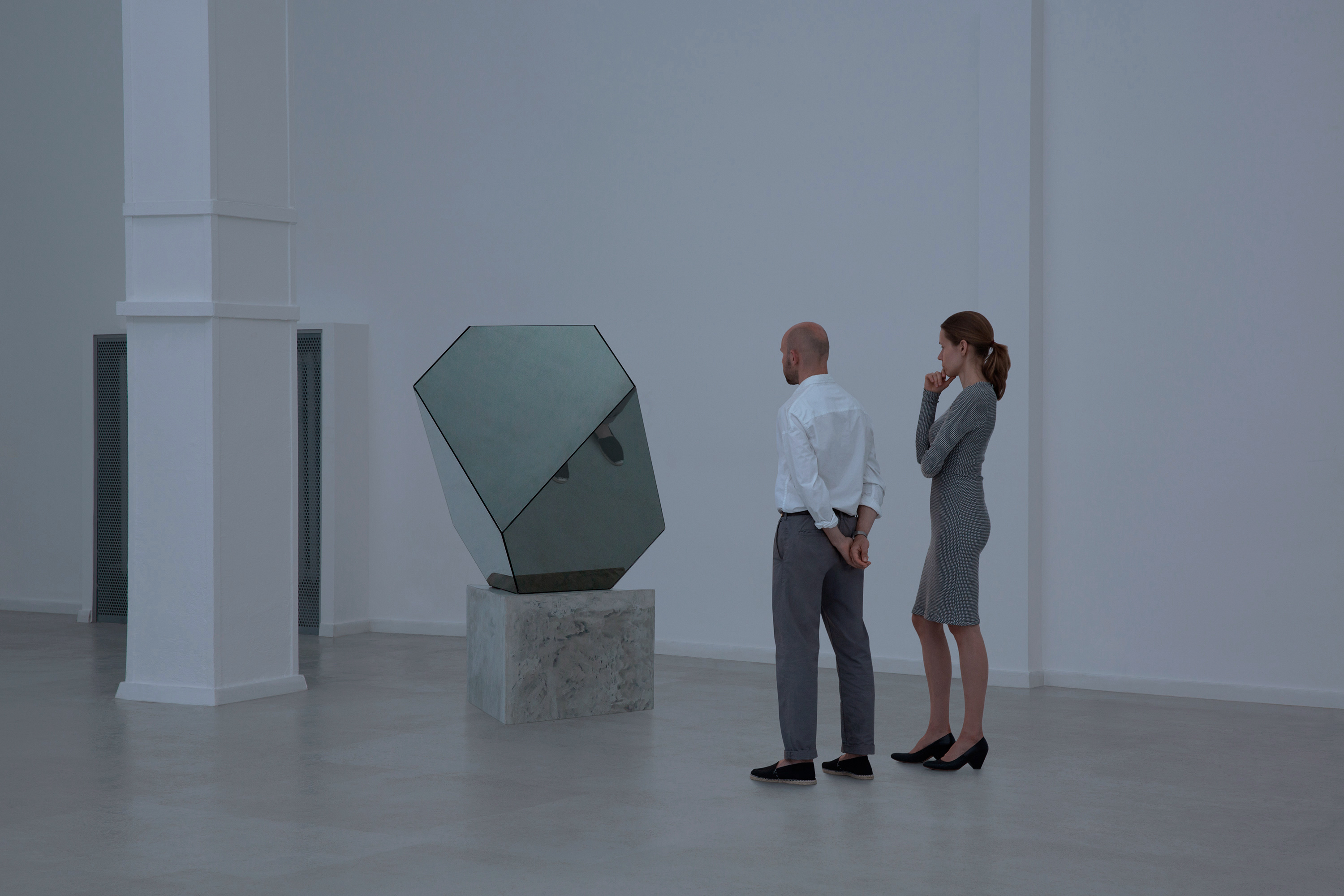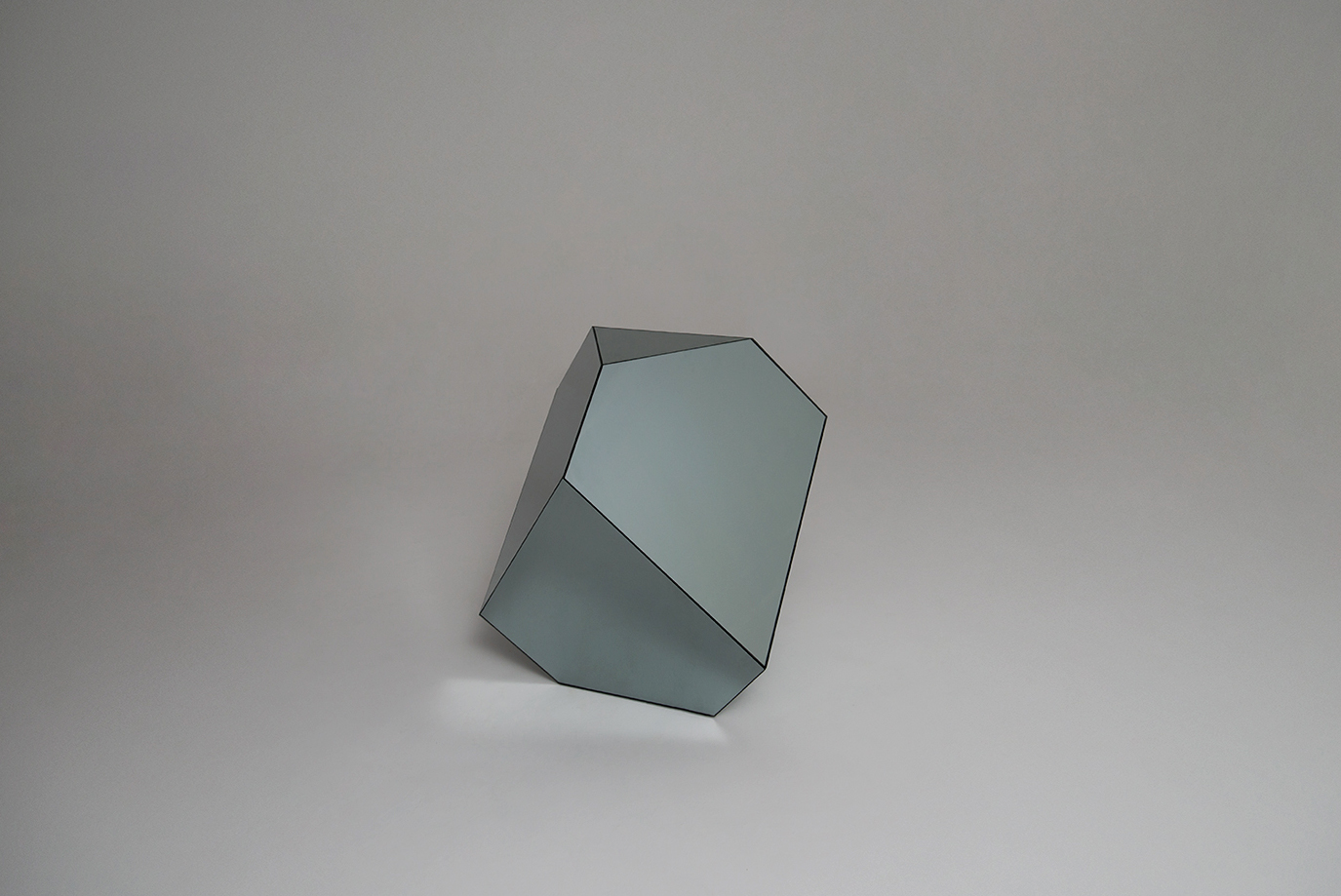Melancholia
Melancholia to interaktywna instalacja dedykowana do przestrzeni publicznej. Wykonana z weneckiego lustra bryła reaguje na otaczający ją dźwięk; kiedy głośność otoczenia schodzi poniżej pewnego progu szkielet instalacji rozświetla się. Melancholia była prezentowana już w przestrzeni galeryjnej, do której wykonana została w mniejszych rozmiarach. Poniżej eksplikacja artystyczna opowiadająca o inspiracji do powstania dzieła, oraz zdjęcia powstałej bryły, oraz rendery pokazujące instalację w przestrzeni publicznej.
O idei:
Kilka lat temu pracowałam nad tematem melancholii jako elementu wrażliwości postmodernistycznej (bo czarne słońce wschodzi zawsze w chwilach przesytu i zwątpienia, gdy wszystkie drogi wydają się już ślepe, bądź wydeptane). Z perspektywy czasu, bardziej niż pracę naukową o literaturze, widzę w tamtych badaniach wyznanie fascynacji podróżą, jaką odbyłam tropem opracowań poświęconych melancholii: od Ciorana, przez Benjamina, Bieńczyka, Földényi’ego, po Burtona i innych. Teksty, którym nietrudno dać się uwieść, opisujące coś bardzo mi bliskiego i osobistego, w nabożnej zadumie analizujące alchemię braku i tęsknoty, kreślące horyzont za którym wysiłek poszukiwania sensu przeplata się nieustannie z gestem zwątpienia. Zdania spowite smutkiem, w którym można się zakochać i zatracić, bo kieruje uwagę w rejony tego co najbardziej ważkie: świadomości własnego losu. A trzeba wiedzieć, że to świadomość absolutna, nie znająca kompromisów; spojrzenie „tych, co nigdy nie odnajdą straty” (jak parafrazując Freuda pisał o melancholikach Bieńczyk) zrównuje wszystko w marności, w swoistym danse macabre, któremu nic nie jest w stanie umknąć.
Pośród wszystkich tych opisów nie ma jednego, który nie odwoływałby się do powstałej 500 lat temu ryciny Dürera. Jej złożona symbolika wciąż pozostaje niewyjaśniona, ale nie ma wątpliwości, że Dürer utwierdził w niej nowożytne wyobrażenie melancholii. W porze, która nie jest ani nocą, ani dniem, u stóp postaci, której obecność równa jest nieobecności, leżą w bezładzie i martwym odrętwieniu porozrzucane przedmioty – atrybuty twórcy. Ukoronowaniem tej tajemnicy jest figura geometryczna, nad którą nietoperz rozpościera skrzydła z wypisanym tytułem Melencolia I. To pierwsze znane przedstawienie tej bryły. Najbliżej jej do półforemnych wielościanów Archimedesa, które artysta studiował badając proporcje i zagadnienia perspektywy. Poza wątkiem badawczym rozpościera się jednak morze spekulacji na temat motywów powstania i znaczenia, jakie kryje ta figura. Czy jest to wyobrażenie kamienia filozoficznego, którego poszukiwania od starożytności rozpalały wyobraźnię uczonych? Czy jej proporcje wynikają ze złotego podziału? Czy na jej powierzchni odbija się zdeformowana ludzka czaszka, cień nadchodzącej śmierci?
Wyjątkowość bryły uczyniła ją metonimicznym symbolem samej melancholii i inspiracją wielu artystów. Stała się też punktem wyjścia mojej obecnej pracy: instalacji odwołującej się do charakterystycznych dla melancholii metafor. Zwierciadła, które u Dürera, jak i u Kierkegaarda jest symbolem melancholicznego rytuału przeglądania się i konfrontowania z możliwością nas samych; labiryntu, przytaczanego przez Borgesa w kontekście mitu o Minotaurze, jako symbolicznej drogi oplatającej zgubne centrum, w którym unicestwienie jest zarazem wyzwoleniem od niekończących się powtórzeń. Oraz najistotniejszy element: wymóg ciszy. Przy odpowiedniej głośności otoczenia konstrukcja instalacji jest nieprzenikniona, lustra odbijają otoczenie. Im wokół jest ciszej, tym intensywniej zaczyna się rozświetlać jej wewnętrzny szkielet, aż do pełnej jasności, przypadającego na moment całkowitej ciszy. Bo cisza jest tym co melancholię przyciąga i w czym melancholia człowieka zanurza. Oddzielająca od świata i uroczysta, jak cisza odmierzana echem kroków wybrzmiewających pod kamiennym sklepieniem pustego kościoła.
—
Melancolia – public space installation
A few years ago I was working on the theme of melancholy as part of the postmodern sensibility (because black sun always rises in times of glut and doubt, when all roads seem to be blind, or beaten). In retrospect, rather than a scientific work on literature, I see in those studies a confession of fascination with voyage, which I took following the studies dedicated to the melancholy: from Cioran, through Benjamin, Bieńczyk, Földényi, ending up with Burton, and others. The texts, by which it is not difficult to get seduced, describing something personal and very close to me, analysing the alchemy of lack and yearning in pious meditation, drawing a horizon behind which the effort of searching for meaning and the gesture of doubt are constantly intertwined. The sentences are shrouded in sadness, with which one can fall in love, in which one can lose, because it directs the attention towards what is the most compelling – the consciousness of one’s own fate. And you have to know that this awareness is absolute, not familiar with trade-offs; a glimpse of “those who never recover what they’ve lost” (as Bieńczyk, paraphrasing Baudlaire, was writing about melancholics) equates all in futility, in a kind of danse macabre, from which nothing can escape.
In the midst of all these descriptions there is non, which would not invoke the engraving by Durer created 500 years ago. Its complex symbolism still remains unexplained, but there is no doubt that Dürer set there a modern image of melancholy. In the time, which is neither night nor day, at the foot of the personage, whose presence is equal to absence, there are items laying, scattered in mess and a dead torpidity, attributes of the creator. The culmination of this mystery is a geometric figure, over which the bat spreads its wings with this inscription spelled out Melencolia I. This is the first known introduction of this solid. It is the closest to Archimedean semiregular polyhedra, which the artist was studying by examining the proportions and perspective issues. Except the element of research, the sea of speculation spreads, concerning the motive behind the creation and meaning concealed by this figure. Is it the idea of the Philosopher’s Stone, the searching for which has been firing the scholars’ imagination since the ancient times? Are the figure’s proportions a result of the golden ratio? Does on its surface a deformed human skull has its reflection – the shadow of approaching death?
The uniqueness of the solid made it a metonymic symbol of the melancholy itself, as well as the inspiration for many artists. It has also become the starting point for my current work – the installation referring to the metaphors characteristic for melancholy. The mirrors, which in Dürer and Kierkegaard are the symbols of melancholy ritual of checking ourselves and confronting with the indefiniteness of our own destiny, the maze cited by Borges in respect to the myth of the Minotaur, a symbolic way wrapping the rough centre, where destruction is also a liberation from the endless tangle of undistinguishable paths. And the most important element – the requirement of silence. With the right volume of surroundings, the solid`s surface is impenetrable, mirrors reflect the surroundings. The more quiet it is, the more illuminated its internal skeleton becomes, until the achievement of full brightness falling on the moment of total silence. Because silence is what attracts melancholy and in which melancholy immerses a man. Solemn and separating from the world, like silence measured by the echo of steps lasting under a stone vault of an empty Church.
Melancholy: an interactive sculpture. Materials: glass, stainless steel, LED light. The dimension determined individually, associated with the context of the place. Five copies provided.



